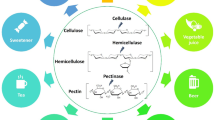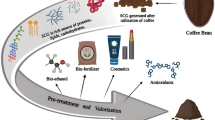Abstract
Grains of common wheat, spelt, emmer, einkorn, rye, barley, oats, and maize (two cultivars each) were germinated for 7 days at 15 and 25 °C, respectively, lyophilized, and milled into flour and bran. The rate of storage protein (prolamins, glutelins) degradation in the bran was determined by an extraction/HPLC method and was used as an indication for gluten-specific peptidase activity. Species and cultivars with high storage protein degradation during germination were selected for further studies. The peptidase activity of the germinated grains was determined by using two gluten substrates namely gliadin (wheat prolamin fraction) and the celiac-toxic peptide PQPQLPYPQPQLPY. The activity assay implied extraction of bran with a sodium acetate buffer (0.2 mol/L, pH 4.0), incubation of the extract with both substrates, and quantitation of gliadin or peptide degradation by RP-HPLC. The assays were simple and generated reproducible values for the peptidase activity. In general, the activity was strongly affected by cereal species, cultivar, germination temperature, and pH value of the application. Some of the bran extracts were capable of degrading both gliadin and the celiac-toxic peptide extensively. Maximum degradation rates of gliadin and the celiac-toxic peptide were 67 and 100 %, respectively. Alternatively, germinated cereal grains were kiln-dried at 45 °C for 24 h instead of being lyophilized and were separated into kernels and roots/sprouts. When compared to the lyophilized bran, the combined kiln-dried material showed a more balanced peptidase activity toward both the gliadin and the peptide substrate.



Similar content being viewed by others
References
Wieser H, Koehler P (2008) The biochemical basis of celiac disease. Cereal Chem 85:1–13
Shan L, Bethune M, Khosla C, Gass J, Pyle GG, Gray GM, Isaacs I, Strohmeier G (2008) Enzyme treatment of foodstuffs for celiac sprue. US Patent Application US 2008095710 A1 20080424
Sollid LM, Koshla C (2005) Future therapeutic options for celiac disease. Nat Clin Pract Gastroenterol Hepatol 2:140–147
Gianfrani C, Auricchio S, Troncone R (2006) Possible drug targets for celiac disease. Expert Opin Ther Targets 10:601–611
Schuppan D, Junker Y, Barisani D (2009) Celiac disease: from pathogenesis to novel therapies. Gastroenterol 137:1912–1933
Hartmann G, Koehler P, Wieser H (2006) Rapid degradation of gliadin peptides toxic for coeliac disease patients by proteases from germinating cereals. J Cereal Sci 44:368–371
Koehler P, Gessendorfer B, Wieser H (2009) Preparation of partially hydrolysed prolamins as references for the immunochemical quantification of gluten in cereal-based beverages. In: Stern M (ed) Proceedings of the 23rd workshop on prolamin analysis and toxicity. Verlag Wissenschaftliche Scripten, Zwickau, pp 35–40
Gessendorfer B, Hartmann G, Wieser H, Koehler P (2011) Determination of celiac disease-specific peptidase activity of germinated cereals. Eur Food Res Technol 232:205–209
Wieser H, Antes S, Seilmeier W (1998) Quantitative determination of gluten protein types in wheat flour by reversed-phase high-performance liquid chromatography. Cereal Chem 75:644–650
Gessendorfer B, Koehler P, Wieser H (2009) Preparation and characterization of enzymatically hydrolyzed prolamins from wheat, rye, and barley as references for the immunochemical quantitation of partially hydrolyzed gluten. Anal Bioanal Chem 395:1721–1728
Wieser H (2000) Comparative investigations of gluten proteins from different wheat species. I. Qualitative and quantitative composition of gluten protein types. Eur Food Res Technol 211:262–268
Chavan JK, Kadam SS (1989) Nutritional improvement of cereals by sprouting. Crit Rev Food Sci Nutr 28:401–437
Wieser H, Vermeulen N, Vogel R (2008) Degradation of gluten proteins during sourdough fermentation. Eur Food Res Technol 226:1495–1502
Dicke WK, Weijers HA, van der Kamer JN (1953) Coeliac disease—the presence in wheat of a factor having a deleterious effect in cases of coeliac disease. Acta Pediatr Scand 42:34–42
Fraser JS, Engel W, Ellis HJ, Moodie SJ, Pollock EL, Wieser H, Ciclitira PJ (2003) Coeliac disease: in vivo toxicity of the putative immunodominant epitope. Gut 52:1698–1702
Ellis HJ, Pollock EL, Engel W, Fraser JS, Rosen-Bronson S, Wieser H, Ciclitira PJ (2003) Investigation of the putative immunodominant T cell epitopes in coeliac disease. Gut 52:212–217
Arentz-Hansen H, Koerner R, Molberg O, Quarsten H, Vader W, Kooy YMC, Lundin KEA, Koning F, Roepstorff P, Sollid LM, Mc Adam SN (2000) The intestinal T cell response to α-gliadin in adult celiac disease is focused on a single deamidated glutamine targeted by tissue transglutaminase. J Exp Med 191:603–612
Shan L, Molberg O, Parrot I, Hausch F, Filiz F, Gray GM, Sollid LM, Koshla C (2002) Structural basis for gluten intolerance in celiac sprue. Science 297:2275–2279
Acknowledgments
The authors thank Leibniz-Gemeinschaft (WGL) for financial support of this project.
Author information
Authors and Affiliations
Corresponding author
Rights and permissions
About this article
Cite this article
Schwalb, T., Wieser, H. & Koehler, P. Studies on the gluten-specific peptidase activity of germinated grains from different cereal species and cultivars. Eur Food Res Technol 235, 1161–1170 (2012). https://doi.org/10.1007/s00217-012-1853-1
Received:
Revised:
Accepted:
Published:
Issue Date:
DOI: https://doi.org/10.1007/s00217-012-1853-1




